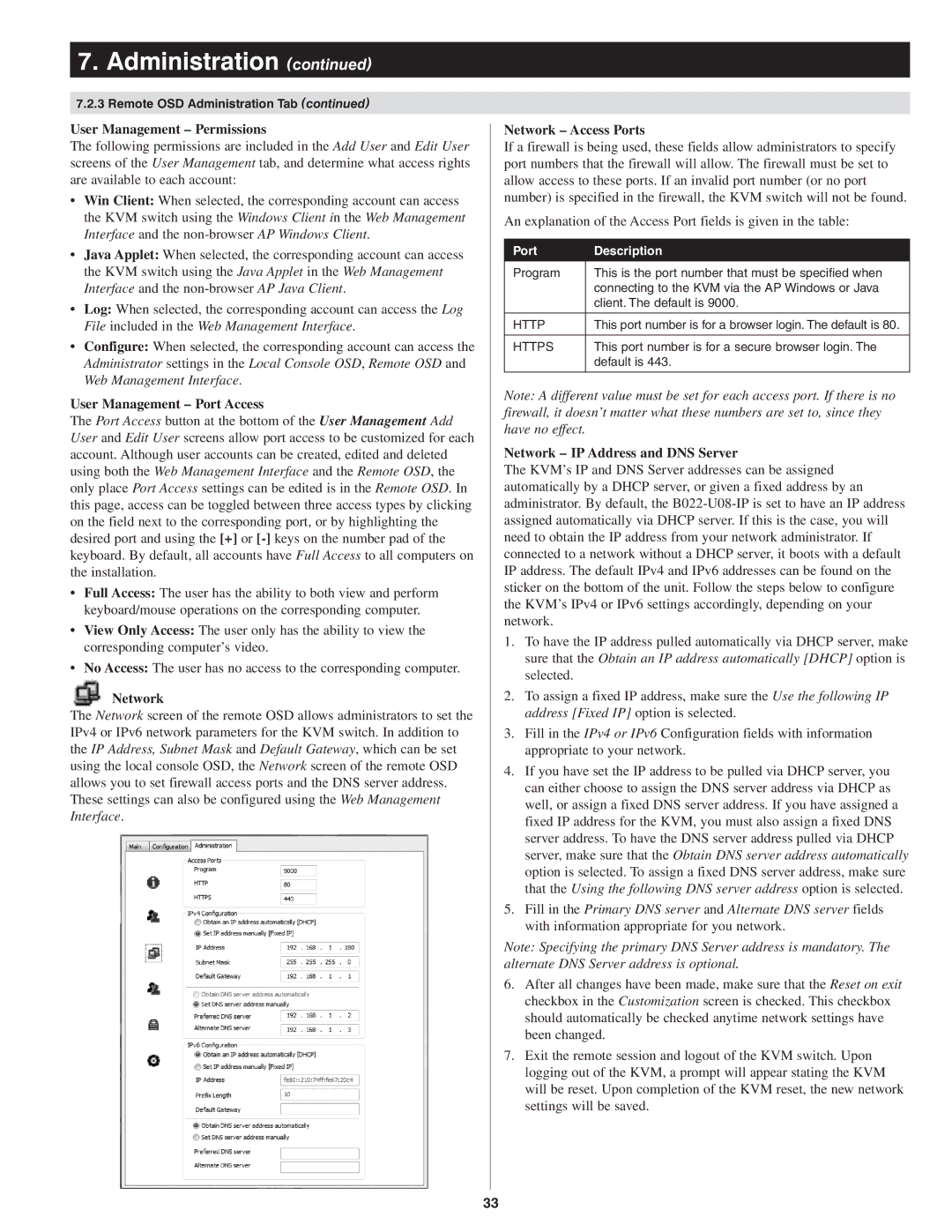
7. Administration (continued)
7.2.3 Remote OSD Administration Tab (continued)
User Management – Permissions
The following permissions are included in the Add User and Edit User screens of the User Management tab, and determine what access rights are available to each account:
•Win Client: When selected, the corresponding account can access the KVM switch using the Windows Client in the Web Management Interface and the
•Java Applet: When selected, the corresponding account can access the KVM switch using the Java Applet in the Web Management Interface and the
•Log: When selected, the corresponding account can access the Log File included in the Web Management Interface.
•Configure: When selected, the corresponding account can access the Administrator settings in the Local Console OSD, Remote OSD and Web Management Interface.
User Management – Port Access
The Port Access button at the bottom of the User Management Add User and Edit User screens allow port access to be customized for each account. Although user accounts can be created, edited and deleted using both the Web Management Interface and the Remote OSD, the only place Port Access settings can be edited is in the Remote OSD. In this page, access can be toggled between three access types by clicking on the field next to the corresponding port, or by highlighting the desired port and using the [+] or
•Full Access: The user has the ability to both view and perform keyboard/mouse operations on the corresponding computer.
•View Only Access: The user only has the ability to view the corresponding computer’s video.
•No Access: The user has no access to the corresponding computer.
Network
The Network screen of the remote OSD allows administrators to set the IPv4 or IPv6 network parameters for the KVM switch. In addition to the IP Address, Subnet Mask and Default Gateway, which can be set using the local console OSD, the Network screen of the remote OSD allows you to set firewall access ports and the DNS server address. These settings can also be configured using the Web Management Interface.
Network – Access Ports
If a firewall is being used, these fields allow administrators to specify port numbers that the firewall will allow. The firewall must be set to allow access to these ports. If an invalid port number (or no port number) is specified in the firewall, the KVM switch will not be found.
An explanation of the Access Port fields is given in the table:
Port | Description |
|
|
Program | This is the port number that must be specified when |
| connecting to the KVM via the AP Windows or Java |
| client. The default is 9000. |
|
|
HTTP | This port number is for a browser login. The default is 80. |
|
|
HTTPS | This port number is for a secure browser login. The |
| default is 443. |
|
|
Note: A different value must be set for each access port. If there is no firewall, it doesn’t matter what these numbers are set to, since they have no effect.
Network – IP Address and DNS Server
The KVM’s IP and DNS Server addresses can be assigned automatically by a DHCP server, or given a fixed address by an administrator. By default, the
1.To have the IP address pulled automatically via DHCP server, make sure that the Obtain an IP address automatically [DHCP] option is selected.
2.To assign a fixed IP address, make sure the Use the following IP address [Fixed IP] option is selected.
3.Fill in the IPv4 or IPv6 Configuration fields with information appropriate to your network.
4.If you have set the IP address to be pulled via DHCP server, you can either choose to assign the DNS server address via DHCP as well, or assign a fixed DNS server address. If you have assigned a fixed IP address for the KVM, you must also assign a fixed DNS server address. To have the DNS server address pulled via DHCP server, make sure that the Obtain DNS server address automatically option is selected. To assign a fixed DNS server address, make sure that the Using the following DNS server address option is selected.
5.Fill in the Primary DNS server and Alternate DNS server fields with information appropriate for you network.
Note: Specifying the primary DNS Server address is mandatory. The alternate DNS Server address is optional.
6.After all changes have been made, make sure that the Reset on exit checkbox in the Customization screen is checked. This checkbox should automatically be checked anytime network settings have been changed.
7.Exit the remote session and logout of the KVM switch. Upon logging out of the KVM, a prompt will appear stating the KVM will be reset. Upon completion of the KVM reset, the new network settings will be saved.
33
